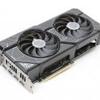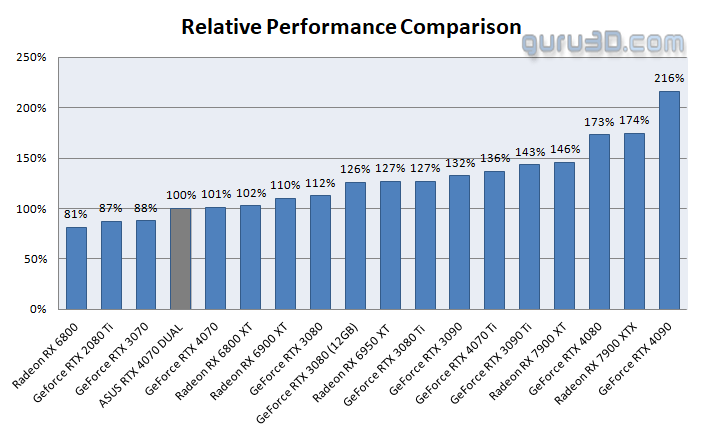Final words and conclusion
Final words
ASUS has broadened its range of graphics cards by unveiling the more cost-effective DUAL GeForce RTX 4070, designed to deliver a solid baseline performance. This compact graphics card, measuring around 27cm, effectively manages heat dissipation with its dual-fan cooling system, maintaining a 65°C threshold. The silent operation, with a noise output of 36-37 dBa, offers a reasonably tranquil gaming experience. NVIDIA has released the GeForce RTX 4070, the latest addition to the ADA product line. With its more affordable price point, this graphics card is now within reach for many end-users. Although NVIDIA heavily promotes the DLSS technology as a game-changer, we hope they won't overlook the importance of raw rasterizer shader performance in future products. The GeForce RTX 4070 boasts a powerful architecture, advanced ray tracing capabilities, and enhanced DLSS technology, significantly improving its performance over its predecessors. However, its performance can fluctuate in less CPU-bound situations, and it may be a bit slower in DX11 yet faster in DX12. Compared to Radeon Series 6000/7000, the RTX 4070's ray tracing performance is faster overall, showing notable advancements in this field. Moreover, with the DLSS3+ Frame generation technology, the GPU can create miracles in games that support it.
Performance
The RTX 4070 offers nice gaming performance and rendering quality. This graphics card offers raw performance levels that enable gaming at 4K resolution, although it's primarily designed for WQHD. With most gamers playing at UWHD, QHD, or UHD monitor resolutions, the 4070 strikes a balance that will appeal to many enthusiasts. Compared to AMD's offerings, the Nvidia GPU will struggle to keep up with the $200 more expensive Radeon RX 7900 XT, but it still has several positive aspects. For example, the DLSS (3) and ray tracing features perform exceptionally well, giving gamers an immersive experience that AMD can't match now. The old rasterizer engine breaks right through the previous limit of extreme performance. The RTX 40 series now has a new generation of Ray tracing and Tensor cores that are more powerful. So, do not let the specific RT and Tensor core counts fool you; it's all about how much performance one unit offers. Since they are close to the shader engine, they have become more efficient, which shows. Tensor cores are harder to measure, but from what we have seen, everything seems to be in good shape, as DLSS3 shows exciting values.
Overall, the GeForce RTX 4070 makes sense at resolutions as low as 2K 2560x1440, and sometimes up to 4K (3840x2160). NVIDIA proclaims this as a 100+ FPS WQHD card, with which we concur.
Cooling & noise levels
During intensive full-load conditions, the graphics card consumes around 200 watts. This power consumption correlates to the heat emitted by the GPU, which is situated within a sealed enclosure. In terms of noise levels, the card produces approximately 36~37 dBA, which is fine. Under stress, the card's temperature may approach ~65°C. This figure may vary based on the airflow efficiency within the computer case. FLIR imaging reveals no cause for concern. It is worth noting that customized cards from board partners might exhibit increased power consumption due to factors such as higher total graphics power and the presence of components like RGB lighting and liquid cooling pumps. This card has no RGB btw.
Energy consumption
In the preceding chapter, we discussed the power consumption of the GeForce RTX 4070 during demanding gaming sessions. The card demonstrates a reasonable power draw, approximately 200 watts (TBP), in exchange for its gaming performance. The power consumption may vary slightly during gameplay, but it often settles around 185 watts. Customized versions from board partners may exhibit higher power usage due to increased TGP allowances. Regarding TGP, our reference test indicates an average power consumption of 185 watts at Ultra HD resolution. We derived the card's TDP of 185 from the measurements taken across five different games.
Coil squeal
The presence of coil squeal in any GeForce RTX 4070 graphics card can vary, depending on the degree of the issue. It becomes audible when reaching high framerates, but typically remains at a manageable level. Within an enclosed case, this sound is likely to blend into the background noise. In our experience with this specific card, the coil squeal has been hardly noticeable.
Pricing
The NVIDIA GeForce RTX 4070 carries a manufacturer's suggested retail price (MSRP) of $599, which still is steep. I believe that the cost of a graphics card should ideally be less than that of a contemporary gaming console. Advanced AIB card models will command a higher price, with this one staying at or below MSRP (we do hope).
Tweaking
You can significantly enhance your GPU's performance by fine-tuning the clock frequency and memory speed. Our efforts have yielded an additional 8% increase in the power limiter. These adjustments offer extra performance within the card's standard power budget, leading to a clock frequency increase of approximately +150-200 MHz. Consequently, you can anticipate your GPU boost clock frequency around the ~2900 MHz range, contingent on the dynamic frequencies of different game titles. Furthermore, by modifying the memory speed to 23 Gbps. Accumulated, you can expect an 6 performance improvement in demanding GPU scenarios compared to the reference (baseline) performance.
Conclusion
The DUAL GeForce RTX 4070 is an MSRP-targeted product, showcasing reference clock frequencies and performance within a 1% margin compared to the Founder's Edition card. With its notable performance in the 2560x1440 resolution range, the ASUS DUAL GeForce RTX 4070 is an fair option for users who desire an elegant design without sacrificing quality. Though not the fastest card on the market, ASUS provides flexibility for customization, allowing an 8% increase in the power limiter to boost the clock speed to 2.9 GHz. Paired with GDDR6 memory running at 23 Gbps, the ASUS DUAL GeForce RTX 4070 offers promising tweakable performance as well, reaching 6% over the founder edition card (but that one tweaks just as well). This card offers three DisplayPort and one HDMI output options, as well as an attractive backplate design. The already impressive factory-tuned performance can be further boosted, particularly when playing games that support DLSS(3). The RTX 4070 excels in providing excellent performance, energy efficiency, and visual quality, positioning itself as a more environmentally friendly alternative to the 4080/4090 graphics cards. With HDMI 2.1 support and a generous 12GB VRAM, the card effortlessly handles high-resolution gaming and intricate creative tasks. While priced similarly to the founder edition, this card is an appealing option for those who value both performance and style. In the end, this is a really proper 4070 baseline product. All AIB partners have a hard time battling that founder edition card from NVIDIA, though, at $599 it is gaming the most silent and great design products with that same baseline performance and tweakability. It's a tough call to make. We, however, find this MSRP model to be among the better ones, and as such it comes recommended (pricing aside from the discussion of course).
- Download NVIDIA GeForce drivers
- Sign up to receive a notification when we publish a new article.
- Or go back to Guru3D's front page
- Hilbert, LOAD"*",8,1.



